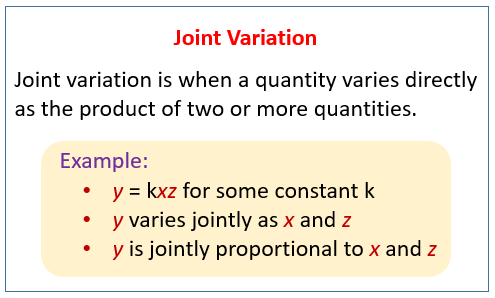Joint or Combined Variation
These lessons help Algebra students learn about joint or combined variation.
Related Pages:
Proportions
Joint Variation Word Problems
Direct Variation
Inverse Variation
More Algebra Lessons
The following figure shows Joint Variation. Scroll down the page for more examples and solutions of Joint and Combine Variations.

What is Joint Variation or Combined Variation?
Joint Variation or Combined Variation is when one quantity varies directly as the product of at least two other quantities.
For example:
y = kxz
y varies jointly as x and z, when there is some nonzero constant k
Joint Variation Examples
Example:
Suppose y varies jointly as x and z. What is y when x = 2 and z = 3, if y = 20 when x = 4 and z = 3?
Example:
z varies jointly with x and y.
When x = 3, y = 8, z = 6. Find z, when x = 6 and y = 4.
Joint Variation Application
Example:
The energy that an item possesses due to its motion is called kinetic energy.
The kinetic energy of an object (which is measured in joules) varies jointly with the mass of the
object and the square of its velocity.
If the kinetic energy of a 3 kg ball traveling 12 m/s is 216 Joules, how is the mass of a ball that
generates 250 Joules of energy when traveling at 10 m/s?
Distinguish between Direct, Inverse and Joint Variation
Example:
Determine whether the data in the table is an example of direct, inverse or joint variation. Then,
identify the equation that represents the relationship.
Combined Variation
In Algebra, sometimes we have functions that vary in more than one element. When this happens, we say that the functions have joint variation or combined variation. Joint variation is direct variation to more than one variable (for example, d = (r)(t)). With combined variation, we have both direct variation and indirect variation.
How to set up and solve combined variation problems?
Example:
Suppose y varies jointly with x and z.
When y = 20, x = 6 and z = 10. Find y when x = 8 and z =15.
Lesson on combining direct and inverse or joint and inverse variation
Example:
y varies directly as x and inversely
as the square of z, and when x = 32, y = 6 and z = 4. Find x when y = 10 and z = 3.
How to solve problems involving joint and combined variation?
Examples:
-
If t varies jointly with u and the square of v, and t is 1152 when u is 8 and v is 4, find t when v is 5 and u is 5.
-
The amount of oil used by a ship traveling at a uniform speed varies jointly with the distance and the square of the speed. If the ship uses 200 barrels of oil in traveling 200 miles at 36 miles per hour, determine how many barrels of oil are used when the ship travels 360 miles at 18 miles per hour.
-
Designer Dolls found that its number of Dress-Up Dolls sold, N, varies directly with their advertising budget, A, and inversely proportional with the price of each doll, P. When $54,00 was spent on advertising and the price of the doll is $90, then 9,600 units are sold. Determine the number of dolls sold if the amount of advertising budget is increased to $144,000.
Combined Variation
Example:
y varies jointly as x and z and inversely as w, and y = 3/2, when x = 2, z =3 and w = 4. Find the equation of variation.
Try out our new and fun Fraction Concoction Game.
Add and subtract fractions to make exciting fraction concoctions following a recipe. There are four levels of difficulty: Easy, medium, hard and insane. Practice the basics of fraction addition and subtraction or challenge yourself with the insane level.

We welcome your feedback, comments and questions about this site or page. Please submit your feedback or enquiries via our Feedback page.